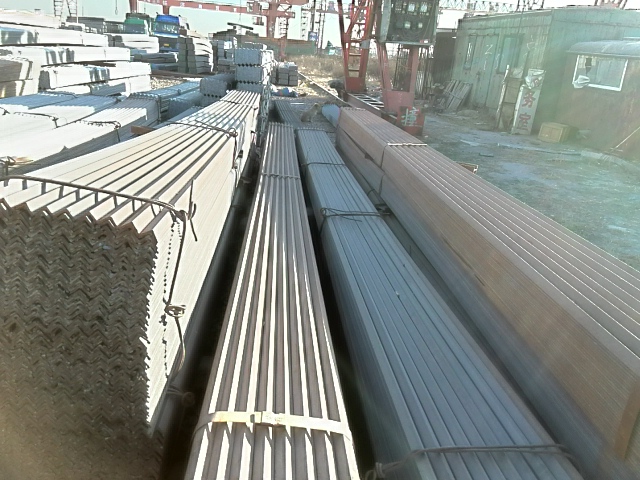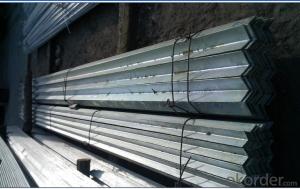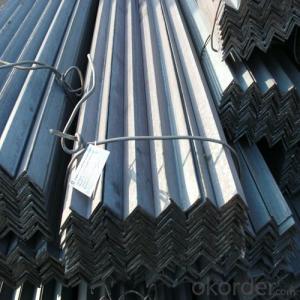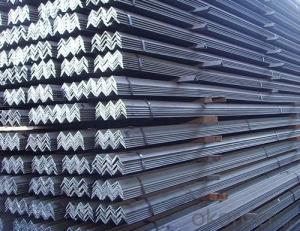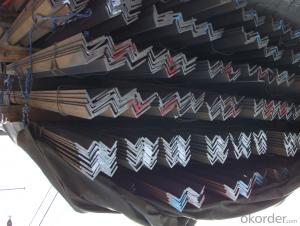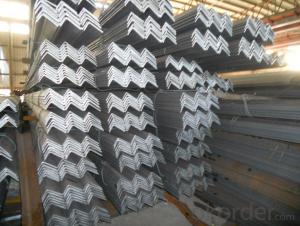Angle steel Bar Many Sizes
- Loading Port:
- China Main Port
- Payment Terms:
- TT or LC
- Min Order Qty:
- -
- Supply Capability:
- -
OKorder Service Pledge
OKorder Financial Service
You Might Also Like
Product Description:
Specifications of Angle Steel Bar
1. Standards: GB,ASTM,BS,AISI,DIN,JIS
2. Length:6m,9m,12m
3. Material:Material: GB Q235B, Q345B or Equivalent; ASTM A36; EN 10025, S235JR, S355JR; JIS G3192, SS400;
SS540.
4. Sizes:
Sizes: 25mm-250mm | ||
a*t | ||
25*2.5-4.0 | 70*6.0-9.0 | 130*9.0-15 |
30*2.5-6.6 | 75*6.0-9.0 | 140*10-14 |
36*3.0-5.0 | 80*5.0-10 | 150*10-20 |
38*2.3-6.0 | 90*7.0-10 | 160*10-16 |
40*3.0-5.0 | 100*6.0-12 | 175*12-15 |
45*4.0-6.0 | 110*8.0-10 | 180*12-18 |
50*4.0-6.0 | 120*6.0-15 | 200*14-25 |
60*4.0-8.0 | 125*8.0-14 | 250*25 |
5. Chemical data: %
C | Mn | S | P | Si |
0.14-0.22 | 0.30-0.65 | ≤0.050 | ≤0.045 | ≤0.30 |
Usage & Applications of Angle Steel Bar
Trusses;
Transmission towers;
Telecommunication towers;
Bracing for general structures;
Stiffeners in structural use.
- Q: How do steel angles contribute to the overall stiffness of a structure?
- Steel angles contribute to the overall stiffness of a structure in several ways. First and foremost, they provide additional support and rigidity to the framework of the structure. Due to their L-shape, steel angles can be used to reinforce the corners and edges of various components, such as beams, columns, and trusses. This reinforcement helps to prevent buckling, twisting, or bending that may occur under heavy loads or external forces. Moreover, steel angles can be strategically placed at key locations within a structure to resist and distribute loads more efficiently. By adding steel angles as bracing elements, the overall stiffness of the structure is enhanced, reducing the chances of excessive deflection or deformation. This is particularly important in structures that are subjected to dynamic loads, such as wind or seismic forces, as the angles help to resist and dissipate these forces throughout the structure. Additionally, steel angles can be interconnected to form a network of diagonal bracing, which significantly improves the overall stiffness and stability of the structure. This bracing system allows the angles to transfer loads from one component to another, effectively reducing the risk of failure or collapse. The use of steel angles in this manner can also help to minimize the amount of material and weight required, making the structure more cost-effective and efficient. In summary, steel angles play a crucial role in contributing to the overall stiffness of a structure by providing reinforcement, supporting key components, and distributing loads. Their versatility and strength make them an essential element in the design and construction of various types of structures, ensuring their stability, durability, and safety.
- Q: What are the different methods for cleaning steel angles?
- To effectively clean steel angles, one can employ various methods: 1. Mechanical Cleaning: By utilizing tools like wire brushes, sandpaper, or abrasive wheels, one can physically scrub away dirt, rust, or contaminants from the steel angles. This method is ideal for light cleaning and can be done manually or with the assistance of power tools. 2. Chemical Cleaning: Stubborn stains, rust, or corrosion on steel angles can be eliminated using chemicals. Acid-based cleaners, such as phosphoric acid or hydrochloric acid, are commonly employed for this purpose. It is crucial to handle these chemicals with care and follow the manufacturer's instructions to ensure safety and prevent any damage to the steel. 3. Electrolytic Cleaning: This method involves immersing the steel angles in an electrolyte solution and applying an electrical current. The electrical current causes the rust or contaminants to dissolve and separate from the surface. Electrolytic cleaning is particularly effective for heavily rusted steel angles, but specialized equipment may be required. 4. High-Pressure Water Cleaning: By utilizing high-pressure water jets, dirt, grime, and loose rust can be effectively removed from steel angles. This environmentally friendly method does not require the use of chemicals. However, it may not be as effective for stubborn stains or heavy corrosion. 5. Blasting: Blasting entails propelling abrasive particles, such as sand, grit, or beads, at high speeds onto the surface of the steel angles. This process aids in the removal of rust, paint, and other contaminants. It is commonly used for heavy-duty cleaning or surface preparation before painting or coating. Choosing the appropriate method depends on the level of contamination, the condition of the steel angles, and the desired outcome. In some instances, a combination of methods may be necessary to achieve optimal results.
- Q: What are the different types of steel angles used in automotive manufacturing?
- In automotive manufacturing, there are several types of steel angles that are commonly used. These steel angles are crucial components in the construction and design of various automotive structures and parts. Some of the different types of steel angles used in automotive manufacturing include: 1. Equal Angle: This type of steel angle has equal length sides that form a 90-degree angle. Equal angles are typically used in automotive manufacturing for structural applications, such as chassis frames, brackets, and suspension components. 2. Unequal Angle: As the name suggests, unequal angles have unequal length sides that form a 90-degree angle. These angles are commonly used in automotive manufacturing to create components with specific dimensions and angles, such as door frames, body reinforcements, and support structures. 3. L Angle: L angles, also known as angle irons, have two equal length sides that form a 90-degree angle. They are widely used in automotive manufacturing for various purposes, including reinforcing panels, mounting brackets, and structural supports. 4. T Angle: T angles have one long side and one short side that form a 90-degree angle, resembling the letter "T." They are commonly utilized in automotive manufacturing for joining different components, such as body panels, fenders, and roof structures. 5. C Angle: C angles, also called channel angles, have a C-shaped cross-section. They are extensively used in automotive manufacturing for applications requiring structural strength and rigidity, such as frame rails, roll cages, and support beams. 6. Z Angle: Z angles have a Z-shaped cross-section, resembling the letter "Z." They are commonly employed in automotive manufacturing for joining and reinforcing various components, such as door frames, roof structures, and body reinforcements. These are just a few examples of the different types of steel angles used in automotive manufacturing. Each type serves a specific purpose and offers unique properties, such as strength, stability, and flexibility, to meet the requirements of different automotive applications.
- Q: Can steel angles be used as supports for suspended acoustical ceilings?
- Yes, steel angles can be used as supports for suspended acoustical ceilings. Steel angles are commonly used in construction for providing structural support and stability. They can be attached to the walls or ceiling to create a framework for suspending acoustical ceiling panels. The angles provide a stable base for the ceiling system and help distribute the weight evenly, ensuring the longevity and durability of the suspended acoustical ceilings.
- Q: How do you calculate the bending moment of a loaded steel angle?
- In order to calculate the bending moment of a loaded steel angle, it is necessary to take into account the applied load, the moment arm, and the cross-sectional properties of the angle. Firstly, one must ascertain the applied load that is acting on the steel angle. This can either be a point load or a distributed load, depending on the specific circumstances. Following this, the point of application of the load must be identified and the moment arm determined. The moment arm represents the perpendicular distance between the point of application of the load and the axis of rotation. Once the applied load and moment arm are known, the bending moment can be calculated using the formula: Bending Moment = Applied Load x Moment Arm Lastly, the cross-sectional properties of the steel angle need to be taken into consideration. These properties encompass the area moment of inertia (I) and the section modulus (Z). The area moment of inertia gauges the resistance to bending and is contingent upon the shape and dimensions of the angle. The section modulus denotes the strength of the section and is computed by dividing the area moment of inertia by the distance from the centroid to the extreme fiber. By employing the appropriate equations and taking into account the cross-sectional properties, it is feasible to ascertain the bending moment capacity of the loaded steel angle and evaluate its structural integrity under the given load conditions.
- Q: Are steel angles heat-treated?
- Yes, steel angles can be heat-treated. Heat treatment is a process in which the steel is subjected to controlled heating and cooling to alter its physical and mechanical properties. This can be done to achieve desired characteristics such as increased strength, hardness, toughness, or improved machinability. Heat treatment of steel angles is commonly carried out using methods such as annealing, quenching, tempering, or normalizing. The specific heat treatment process employed depends on the desired final properties and the intended application of the steel angles.
- Q: How are steel angles tested for quality and strength?
- Various methods are employed to examine and assess the quality and strength of steel angles, guaranteeing their compliance with the necessary standards and specifications. The tensile test stands as one of the primary examinations conducted on steel angles, gauging their capacity to resist breaking when subjected to tension. This examination entails gradually increasing the load on a steel angle sample until it reaches its breaking point. The maximum load endurance is measured, providing crucial insights into the material's tensile strength. Another crucial evaluation is the hardness test, which determines the steel angle's ability to resist indentation. By conducting this test, one can assess the material's capability to withstand wear and tear as well as its overall strength. Hardness is typically measured using the Rockwell or Brinell scales, with higher hardness indicating greater strength. To ensure the steel angle's quality, professionals with specialized training meticulously inspect the angles for any surface defects that could compromise their structural integrity. Cracks, uneven surfaces, and deformities are thoroughly examined during these visual inspections. Additionally, chemical composition analysis may be conducted to verify that the steel angle meets the required specifications. This analysis examines the percentage of various elements present in the steel, such as carbon, manganese, and sulfur, as these directly impact the angle's strength and durability. Overall, steel angles undergo rigorous testing for quality and strength through a combination of physical, visual, and chemical examinations. These tests provide assurance that the angles can withstand intended loads and safely perform in various applications, instilling confidence in their reliability and longevity.
- Q: What is the maximum thickness of a steel angle?
- The maximum thickness of a steel angle is typically determined by the manufacturing process and the specific requirements of the application. Generally, steel angles can range in thickness from 1/8 inch to several inches. However, it is important to note that the availability of thicker steel angles may vary depending on the supplier and the specific grade of steel being used. In order to determine the maximum thickness of a steel angle for a particular project, it is recommended to consult with a structural engineer or a steel supplier who can provide guidance based on the specific requirements and load-bearing capacities needed.
- Q: Can steel angles be used in playground or recreational equipment?
- Absolutely! Playground or recreational equipment can definitely make use of steel angles. Steel angles are incredibly versatile and sturdy as a structural material, making them perfect for a wide range of purposes in playground or recreational equipment. They offer stability, support, and long-lasting durability, which makes them ideal for use in various structures like climbing frames, swing sets, slides, and other equipment. Given their ability to withstand heavy loads, impact forces, and even harsh weather conditions, steel angles are often used to create frames, posts, and supports in playground equipment. What's great is that these angles can be easily customized and fabricated to meet specific design requirements, ensuring that the equipment is both safe and functional.
- Q: How are steel angles installed on concrete structures?
- Steel angles are commonly used in concrete structures to provide additional strength and support. The process of installing steel angles on concrete structures involves a few steps. First, the concrete surface needs to be prepared. This includes cleaning the surface thoroughly and removing any debris or loose material. The concrete should be in a sound condition, free from cracks or other structural issues. Next, the steel angles need to be positioned and marked on the concrete surface. This is typically done by using a measuring tape and a chalk line. The angles are usually placed at specific intervals and locations, based on the structural requirements. After marking the positions, the concrete surface needs to be drilled. This is done using a drill and a masonry bit that is appropriate for the size of the anchor bolts or fasteners that will be used. The holes should be drilled to the required depth, ensuring a secure and stable installation. Once the holes are drilled, anchor bolts or fasteners are inserted into the holes. These bolts or fasteners are specifically designed for securing steel angles to concrete surfaces. They are typically made of steel and have a threaded end that allows them to be tightened securely into the concrete. After inserting the anchor bolts or fasteners, the steel angles are positioned and aligned with the marked locations on the concrete surface. The angles are then secured to the concrete by tightening the nuts on the anchor bolts or fasteners. Finally, the installation is checked for accuracy and stability. The angles should be firmly attached to the concrete surface and should not move or shift when pressure is applied. Any adjustments or additional tightening may be necessary to ensure a secure and reliable installation. Overall, the process of installing steel angles on concrete structures involves careful preparation, drilling, anchoring, and securing. This ensures that the angles provide the necessary strength and support required for the specific application.
Send your message to us
Angle steel Bar Many Sizes
- Loading Port:
- China Main Port
- Payment Terms:
- TT or LC
- Min Order Qty:
- -
- Supply Capability:
- -
OKorder Service Pledge
OKorder Financial Service
Similar products
Hot products
Hot Searches
Related keywords


